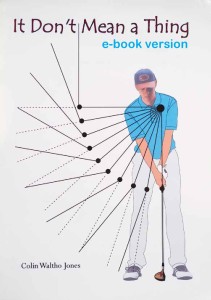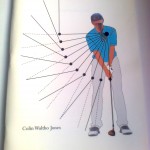Bad shots. The brilliant advantage of this method over any other is that bad shots will not have the corrosive effect they may have had in the past. In the Bell South Classic in 1967, Jack Nicklaus shanked a five-iron fifty yards into the rough on the 15th in the last round. He went birdie, eagle, birdie to win the tournament. When asked about the shank he replied that he had been annoyed but that by the time he had reached the ball to play the next shot he could only think about what needed doing.
With this method you are only ever looking for the rhythm. When you hit a bad shot there will be enough time before the next shot to remind yourself that a bad shot is just a mis-timed shot and you just need to find that rhythm that guarantees “timing”. However, the real advantage of this is that it enables you to play with freedom because you will not be afraid that a bad shot is going to spoil the round by throwing you off course. You have access to “timing” at all times and so can play with a real imaginative (and physical) freedom. A shot that doesn’t come off will feel just that – a shot that didn’t come off! So what! What’s the next shot?
——————————————————————————————
[2. Getting stuck in a bunker]
The only reflection needed for bad shots is: “what was the next one like?” If the next shot was a good one then you must have succeeded in simply moving to the ball after the bad shot and going through the routine and finding the rhythm, which makes the 3 out of a bunker and then the 3-putt a more interesting sequence to consider. Before doing that I want to dispel a myth: the course did not jump up and bite you – you simply hit a sequence of shots that didn’t have the desired outcome. Don’t blame things like fate, history or reputation for your bad shots – only you are swinging the club! Also, don’t blame the conditions: you may not have known about the frozen sand but at worst it only cost you a shot.
Psychologically, it is much more beneficial to take full responsibility for your bad shots at the time, because you need to get cross with yourself in order to wake up your imagination and by extension your subconscious so that your visualisation routine gets more vivid.
I don’t know the hole yet but you shouldn’t have been anywhere near that bunker. The aim is to have control of the ball off the tee so that the next shot is the easiest it can be. Think back to the tee shot and see if there is anything that you did or didn’t do that made the dribble into the bunker more likely than it should have been. Consider your club selection, the conditions, what happened on the tee (interruptions, waits, gusts, banter etc). Most importantly, try to remember your visualisation: did you factor in the importance of avoiding the deepest bunker on the course? Was there a “safer” spot to aim for given the pin position, wind etc? From your description it sounds as if you weren’t quite switched on when thinking about the tee shot, but I might be wrong


